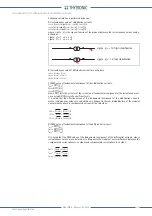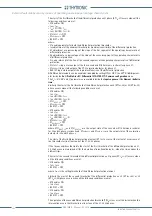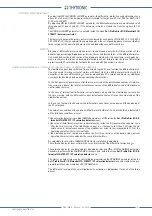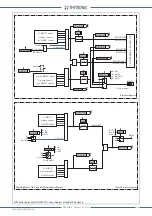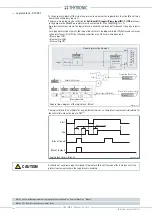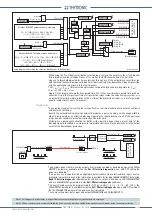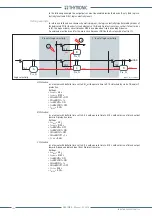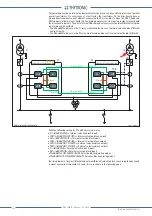
FUNCTION CHARACTERISTICS
241
NVA100X-D - Manual - 02 - 2016
CROSS H-REST parameter
By adjusting
OFF
the
CROSS H-REST
parameter, the differential protection can be blocked at one
phase (L1 or L2 or L3) if the harmonic restraint is started for that phase (ST-H-L1 REST or REST-H-ST
H-ST or L2-L3 REST).
By adjusting
ON
the
CROSS H-REST
parameter, the differential protection can be blocked in all
three phases (L1 and L2 and L3) if the harmonic restraint is started in at least one phase (ST H-
REST).
The
CROSS H-REST
parameter is available inside the menu
Set \ Profi le A(or B) \ Differential 87G-
87M-87T \ harmonic restraint
.
The logic state output of harmonic restraint considered for each phase (87 H-REST-L 1, 87 H-REST-L
2, 87 H-REST-L 3) is only enabled if the operating point in the corresponding phase stays over the fi rst
three sections of the operating characteristic and below the second threshold
I
d
>>.
BLOCK
Blocking of differential protection by harmonic restraint covers only the fi rst three sections of the
double slope percentage tripping characteristic; the second threshold
I
d
>> of the differential protec-
tion, which defi nes the fourth section of the tripping characteristic, it is nevertheless locking by har-
monic restraint so that to have a back-up protection in case of failure inside the zone of differential
protection with CT saturation that activate the second and fi fth harmonic restraint.
Additional stabilization on through current by means of saturation detector
To stabilize at current loops with long time constants (eg short circuit outside the differential protec-
tion of generator starting current of motors with direct start), the differential protection (with the
exception of the second threshold
I
d
>>) can be blocked by a CT’s saturation detector as additional
security to the double slope percentage operating characteristic.
In the fi rst quarter of power cycle after the zero crossing of the instantaneous values of stabiliza-
tion current in a phase, the level of instantaneous values of the differential current at that phase is
controlled by the relay.
In the case of internal fault differential current appears along with the stabilization current after
the zero crossing, with the differential current instantaneous value of twice the actual value of the
stabilization current.
In the case of external fault however, the differential current does not appear until the beginning of
the CT saturation.
The saturation condition of in one phase (87SatDet or 87SatDet-L1-L2-L3 or 87SatDet) is detected if
all the following conditions are met:
the saturation detector is enabled (
SatDet
parameter set
ON
inside the
Set \ Profi le A(or B) \ Dif-
ferential 87G-87M-87T \ CT saturation detector
menu),
the value of the differential current, in absolute value, inside the fi rst quarter of each power cycle
after the zero crossing of the stabilization current is, at that phase, less than 1.34 times the ab-
solute value of instantaneous value of the stabilization current in (corresponding to 77 % of the
operating characteristic for internal fault),
the operating point at that phase is above the fi rst three sections of the double slope percent
operating characteristic and below the second threshold
I
d
>>.
An adjustable recovery time
tSatDet-RES
detector saturation is adjustable.
The saturation detector does not block the second threshold of the differential protection
I
d
>>.
The saturation detector can be enabled or disabled by selecting
ON
or
OFF
the
SatDet
parameter,
available, together with the
tSatDet-RES
recovery time, within the menu
Set \ Profi le A(or B) \ Dif-
ferential 87G-87M-87T \ CT saturation detector
menu.
The start of an output relay can be controlled by programming the
STSatDet
parameter inside the
Set \ Profi le A(or B) \ Differential 87G-87M-87T \ CT saturation detector
menu and similarly the pro-
gramming state can be viewed on LED (
STSatDet-L
).
The differential locking at the saturation detector activation is independent for each of the three
phases.
1)
2)
3)











